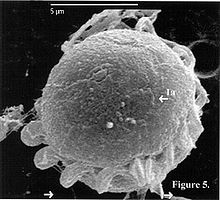Pseudopfiesteria shumwayae
| Pseudopfiesteria shumwayae | |
|---|---|

| |
| Pseudopfiesteria shumwayae SEM micrograph | |
| Scientific classification | |
| Domain: | Eukaryota |
| Clade: | Diaphoretickes |
| Clade: | SAR |
| Clade: | Alveolata |
| Phylum: | Myzozoa |
| Superclass: | Dinoflagellata |
| Class: | Dinophyceae |
| Order: | Thoracosphaerales |
| Family: | Pfiesteriaceae |
| Genus: | Pseudopfiesteria |
| Species: | P. shumwayae
|
| Binomial name | |
| Pseudopfiesteria shumwayae Glasgow & Burkholder
| |
Pseudopfiesteria shumwayae (formerly placed in the genus Pfiesteria; see 'Taxonomy' section below) is a species of heterotrophic dinoflagellates in the genus Pseudopfiesteria. It was first characterized in North Carolina in 2000.[1] It can acquire the ability for photosynthesis through eating green algae and retaining their chloroplasts. It can also turn predatory and toxic. Strains of Pseudopfiesteria shumwayae have been implicated in fish kills around the US east coast. Pseudopfiesteria shumwayae has been described as having a less complex life cycle than Pfiesteria piscicida.[2]
Toxicity[edit]
While toxic strains of Pseudopfiesteria shumwayae have been implicated in fish kills, its ability to secrete an exotoxin to kill its prey has been subject to controversy.[3] A study published in 2002 has shown that it is capable of killing fish by direct contact and feeding on their skin through micropredation.[4] Toxicity levels appear to depend on the strains and assays used in the laboratory.[5] Pfiesteria shumwayae toxin present in filtered water can cause cognitive deficits in rats.[6]
Taxonomy[edit]
Based on 2005 research, the organism previously known as Pfiesteria shumwayae should be reassigned its own genus, based on both morphological analysis and molecular evidence as supported by rDNA analysis. Although closely resembling Pfiesteria piscicida, it differs in two important precingular plates 5" and 6", which historically, only one plate difference would be sufficient to place in a separate genus. The species ' shumwayae ' has thus been categorized in a more recently erected genus, Pseudopfiesteria.[7]
Occurrence[edit]
Pfiesteria has a worldwide distribution and is typically found in estuaries and coastal habitats. It is usually benign unless it "blooms" to a high concentration. High concentrations of Pseudopfiesteria shumwayae have been found in the following locations:
- Taskinas Creek, a tributary of the York River in James City County, Virginia, in March 2005.[8]
References[edit]
- ^ "NC State News Release, March 10, 2000: NC State Scientists Confirm Second Toxic Pfiesteria Species". Archived from the original on March 18, 2007. Retrieved 2008-01-06.
- ^ Burkholder JM, Glasgow HB, Deamer-Melia NJ, et al. (2001). "Species of the toxic Pfiesteria complex, and the importance of functional type in data interpretation". Environ. Health Perspect. 109 (Suppl 5). Environmental Health Perspectives, Vol. 109: 667–79. doi:10.2307/3454912. JSTOR 3454912. PMC 1240596. PMID 11677174.
- ^ Miller TR, Belas R (2003). "Pfiesteria piscicida, P. shumwayae, and other Pfiesteria-like dinoflagellates". Res. Microbiol. 154 (2): 85–90. doi:10.1016/S0923-2508(03)00027-5. PMID 12648722.
- ^ Vogelbein WK, Lovko VJ, Shields JD, et al. (2002). "Pfiesteria shumwayae kills fish by micropredation not exotoxin secretion". Nature. 418 (6901): 967–70. Bibcode:2002Natur.418..967V. doi:10.1038/nature01008. PMID 12198545. S2CID 4388577.
- ^ Burkholder JM, Gordon AS, Moeller PD, et al. (2005). "Demonstration of toxicity to fish and to mammalian cells by Pfiesteria species: comparison of assay methods and strains". Proc. Natl. Acad. Sci. U.S.A. 102 (9): 3471–6. Bibcode:2005PNAS..102.3471B. doi:10.1073/pnas.0500168102. PMC 552923. PMID 15728353.
- ^ Duncan PM, Parris B, Schultz S, et al. (2005). "Behavioral effects and drug vulnerability in rats exposed to Pfiesteria toxin". Neurotoxicol Teratol. 27 (5): 701–10. doi:10.1016/j.ntt.2005.06.008. PMID 16198085.
- ^ "Archived copy" (PDF). Archived from the original (PDF) on 2011-07-20. Retrieved 2011-02-15.
{{cite web}}: CS1 maint: archived copy as title (link) - ^ "Chesapeake Bay Foundation - Save the Bay: High Concentrations of Pfiesteria Underscore Need to Reduce Pollution". Archived from the original on 2007-09-28. Retrieved 2008-01-06.
This article needs additional or more specific categories. (April 2022) |
